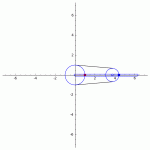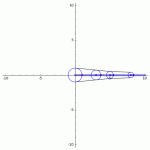Project: Visualizing the Fourth Dimension with Virtual Reality
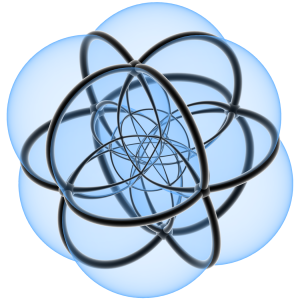
Faculty supervisor: David Dumas
Student researchers: Brandon Reichman
Description: We will create a series of virtual reality (VR) experiences illustrating the geometry of four-dimensional spaces and four-dimensional mathematical objects using the Unity 3D graphics engine and the lab’s Oculus Rift head-mounted VR display. This series of short VR experiences will start with familiar objects and interactions and gradually introduce more complicated aspects of four-dimensional geometry, thus making ideas of higher-dimensional geometry accessible to a broad audience of VR users.
Outcomes: We created a virtual reality experience where the user can directly interact with projections of four-dimensional objects. The application was programmed in C# and created with the game development software Unity along with the Oculus virtual reality headset and Touch controllers. The application has the capability of reading arbitrary four-dimensional OBJ files and rendering them in a virtual environment. Using the Touch controllers, user has the ability to apply three-dimensional and four-dimensional rotations on these objects. This program can be used to aid one’s understanding of space, objects, and rotations in four dimensions.
Materials and resources:
- Poster
- 4DVR for 32-bit Windows (build from 2018-05-03)
- 4DVR for 64-bit Windows (build from 2018-05-03)
- Source code repository:
Project: Visualizing polytopes in 4 dimensions: the work of Alicia Boole Stott
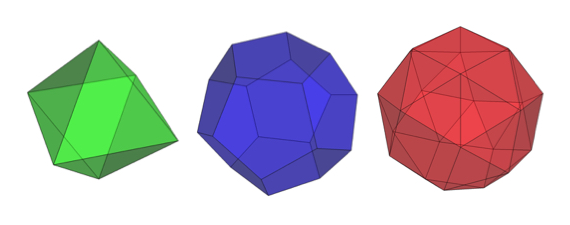
Faculty supervisor: Olga Lukina
Student researchers:Neelima Borade, Ryan Gleason
Description: Alicia Boole Stott was an amateur mathematician of the 19-20th century, who lived in Ireland and Britain. She worked on visualizing polytopes in 4 dimensions by building cardboard models of their 3-dimensional sections. In visualizing the 4th dimension, she developed an original approach, very different from the one adopted by the trained mathematicians of the time. She was the first to discover the 45 semi-regular polytopes in the 4th dimension. Later in life, she collaborated with mathematicians Schoute and Coxeter, and was awarded an honorary doctorate from the University of Groningen at the celebration of its 300 year anniversary. The goal of this project is to understand Alicia Boole Stott’s method of building sections of regular and semi-regular polytopes, and to 3D print these models.
Outcomes: We began the semester by reading Chapter 5 of the PhD thesis, Theory and History of Geometric Models, written by Irene Polo-Blanco. From the thesis, we learned about the life of Alicia Boole Stott and her mathematical accomplishments. We found it very interesting that Alicia had only studied the first two books from “Euclid’s Elements”, which consequently led us to work through the book’s first 20 proofs. It was quite fascinating to look back at how much we can prove about geometry from very basic ideas and definitions.
Next, we began to look at regular convex polytopes. We started by looking at the three-dimensional space, and we proved that there is precisely five regular convex polytopes that exist in three dimensions. We did so by calculating the maximum number of polytopes that can fit together from combinations of their angles not exceeding 360 degrees.
We spent the rest of our time working through the unfolding of regular convex polyhedra in the 4th dimension, using Alicia Boole Stott’s method. During this time, we discussed the various sections together on the blackboard, and worked on generating ideas and models for 3D printing. Creating the models from scratch was a very tedious process at times, but in the end it was very rewarding. In our discussions, we began using the models to help our understanding and in explaining the concepts of unfolding 4 dimensional objects. Our experimentation with 3D printing did have its failures, as well as a few ideas that never came completely together. With some perseverance, we pulled ourselves up by our bootstraps, and we built for ourselves a very solid foundation of knowledge, encompassing a multitude of 3D printing software, applications, and coding methods. In the end, we are proud of our hard work, and we are pleased with the various 3D models produced.
Materials and resources:
Project: Wikipedia Math Illustration Task Force
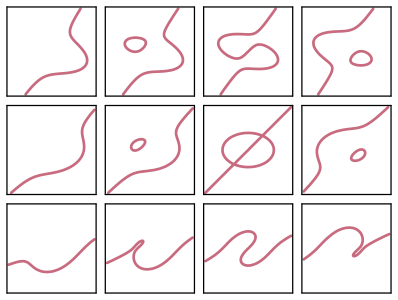
Faculty supervisor: Jan Verschelde
Student researchers:Amy Herz, Jacob Krol
Description: The goal of this project is to improve the mathematical content of Wikipedia by contributing new or improved illustrations (graphs, diagrams, animations) to articles that would benefit from them—focusing especially on articles about plane curves and algebraic curves. This is a great way to learn about programming techniques and tools for creating mathematical images while also making a valuable contribution to the mathematical community.
(This project was inspired by a Spring 2016 project at the Washington Experimental Mathematics Lab.)
Outcomes: We chose to provide animations for the Wikipedia page on Kempe’s Universality Theorem, which states that for any algebraic plane curve, a linkage can be constructed to draw that curve. Just reading Kempe’s theorem it can be difficult to conceptualize such a broad statement, thus we set to work creating GIFs that could display his theorem at work.
Our first task was to do research to understand Kempe’s Theorem ourselves. There were several articles referenced in the Wikipedia page that enlightened us and one in particular by Y. Liu and J. M. McCarthy that had applied Kempe’s Theorem to design their own mechanisms. We decided to replicate these mechanisms using Sage for our animations – one that drew the curve of a trifolium and one that drew a hypocycloid using a single coupled serial chain. We split their mechanisms into components: two circles, a crank, two chains, two arms, and the curves being drawn. For every frame, our program calculated the position of these components connected to the same input angle θ and driven by chains at increasing speeds by pulleys of decreasing radius. After getting our mechanisms running smoothly we uploaded our animations to the Wikipedia article, making our project a success.
Media:
Materials and resources:


